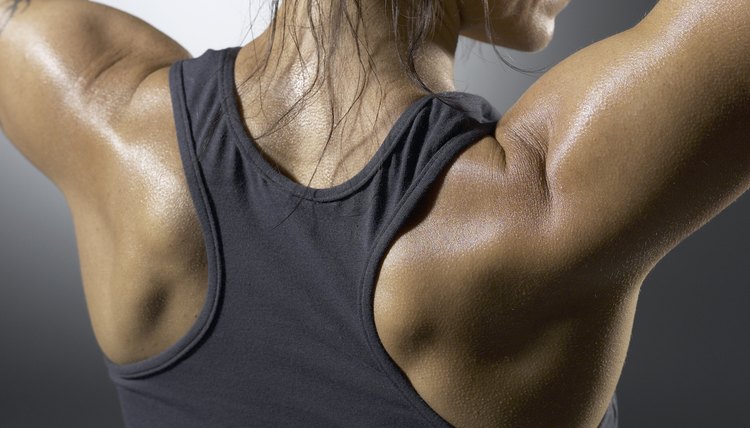What does fact checked mean?
At SportsRec, we strive to deliver objective content that is accurate and up-to-date. Our team periodically reviews articles in order to ensure content quality. The sources cited below consist of evidence from peer-reviewed journals, prominent medical organizations, academic associations, and government data.
The information contained on this site is for informational purposes only, and should not be used as a substitute for the advice of a professional health care provider. Please check with the appropriate physician regarding health questions and concerns. Although we strive to deliver accurate and up-to-date information, no guarantee to that effect is made.
Rolling Shoulder Shrugs

There’s one rule of thumb when doing shoulder shrugs with or without the use of dumbbells or other forms of resistance: don’t roll your shoulders! Rolling your shoulders is a big “no-no” while performing shoulder shrug exercises and can limit the effectiveness of the exercise while increasing the possibility of injury. Instead, focus on proper form and technique to increase your strength, bulk and definition in your trapezius muscles with shoulder shrugs.
Shoulder Shrugs
Shoulder shrugs focus on building up the trapezius muscles, and can be performed using dumbbells or a barbell. When using dumbbells, start by planting your feet shoulder-width apart, holding a dumbbell in each hand with your palms facing your body. Simply raise your shoulders straight up toward the ceiling slowly and with control, pause at the top of the movement, then lower your shoulders back to the start position.
Rolling Your Shoulders
According to ExRx.net, there is no point in rolling your shoulders while performing shoulder shrugs. Rolling your shoulders creates a horizontal motion that is perpendicular to gravity rather than the up-and-down motion created by shrugging the shoulders that uses gravity as resistance to better work the muscle.
Technique
Avoiding rolling your shoulders is rule number one when performing shoulder shrugs, but there are other issues of technique that should be followed to avoid injury. The focus of the shoulder shrug movement is the upper trapezius. The middle and lower traps should not be engaged during this exercise by pulling the shoulder blades together because doing so decreases the focus on the upper traps and minimizes the overall effectiveness of the movement.
Warnings
If your dumbbells are exceptionally heavy, consider performing the shoulder shrug with wrist straps until you adapt to the weight. This will allow you to get a better grip on the barbells and avoid inadvertently hurting yourself by straining your forearms. For exceptionally heavy weight, it may also be helpful to wear a weight belt for more support and to protect your lower back. If you do strain your shoulders or forearms, stop the exercise and rest the muscles. If pain persists, contact your doctor.
References
- ExRx.net: Common Resistance Training Mistakes
- ExRx.net: Dumbbell Shoulder Shrug
- Moseley JR, J. B., Jobe, F. W., Pink, M., Perry, J., & Tibone, J. (1992). EMG analysis of the scapular muscles during a shoulder rehabilitation program. The American Journal of Sports Medicine, 20(2), 128-134. Â
- Hintermeister, R. A., Lange, G. W., Schultheis, J. M., Bey, M. J., & Hawkins, R. J. (1998). Electromyographic activity and applied load during shoulder rehabilitation exercises using elastic resistance. The American Journal of Sports Medicine, 26(2), 210-220.
- Handa, T., Kato, H., Hasegawa, S., Okada, J., & Kato, K. (2005). Comparative electromyographical investigation of the biceps brachii, latissimus dorsi, and trapezius muscles during five pull exercises. Japanese Journal of Physical Fitness and Sports Medicine, 54(2), 159-168.
- Schoenfeld, B., Kolber, M. J., & Haimes, J. E. (2011). The upright row: Implications for preventing subacromial impingement. Strength & Conditioning Journal, 33(5), 25-28.
- McAllister, M. J., Schilling, B. K., Hammond, K. G., Weiss, L. W., & Farney, T. M. (2013). Effect of grip width on electromyographic activity during the upright row. The Journal of Strength & Conditioning Research, 27(1), 181-187.
- Reinold, M. M., Escamilla, R., & Wilk, K. E. (2009). Current concepts in the scientific and clinical rationale behind exercises for glenohumeral and scapulothoracic musculature. Journal of Orthopaedic & Sports Physical Therapy, 39(2), 105-117.
- Johnston, T. B. (1937). The movements of the shoulderâjoint a plea for the use of the 'plane of the scapula' as the plane of reference for movements occurring at the humeroâscapular joint. BJS, 25(98), 252-260.
- Greenfield, B. (1994). Special considerations in shoulder exercises: plane of the scapula. The athleteâs shoulder. Churchill Livingstone, New York, 513-522.
- Ekstrom, R. A., Donatelli, R. A., & Soderberg, G. L. (2003). Surface electromyographic analysis of exercises for the trapezius and serratus anterior muscles. Journal of Orthopaedic & Sports Physical Therapy, 33(5), 247-258.
Writer Bio
Rick Rockwell is a self-employed personal trainer and experienced freelance writer. His articles have been published throughout the Internet. He has more than eight years of experience as a certified personal trainer, group fitness instructor and lifestyle coach. His company, Rockwell Fitness, is dedicated to educating and empowering others to live healthy lifestyles.
